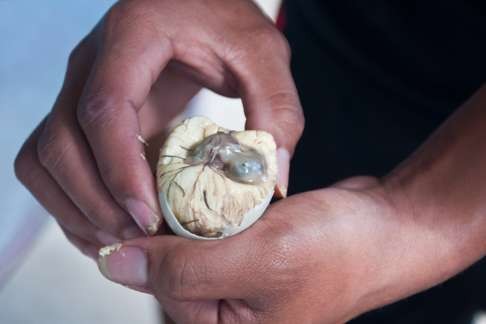
From fried spider to grilled bat, four of the best Southeast Asian foodie tours
For travellers ready for culinary adventure that goes beyond phad Thai and pho, tours of market stalls and roadside vendors in Cambodia, Vietnam, the Philippines and Myanmar can be an eye-opener
Southeast Asia is a dream destination for foodies, boasting a kaleidoscope of flavours, cooking techniques and unique dishes that are tempting tourists to try.
Popular dishes, such as Vietnamese pho and Thailand’s phad Thai have been on the radar of global gastronomes for decades. But the more acquired tastes of other countries in the region have largely been left to locals. As intrepid travellers’ curiosity grows, this is changing as more dare to try some of the quirkier dishes on the menu.
“Food has strong connections with culture and heritage and serves as an additional way to connect travellers with a country and its people,” says Jens Thraenhart, executive director of the Mekong Tourism Coordinating Office, which is spearheading a region-wide food tourism drive.
From fried tarantula and scorpion lollipops to cow penis and half-fertilised eggs, tourists’ taste buds are being pushed to the limits. We take a look at some of the top tours exploring these intriguing eats.

Siem Reap, Cambodia
“We want to show people real Cambodian cuisine in a unique way,” says co-founder Ly Akim, whose guests ride pillion on a Vespa to take in the sights and smells. You might need a strong stomach to tackle some of the delicacies served up during this alternative tour of Siem Reap. Stalls are full of rattan baskets spilling over with bulging water beetles, grasshoppers, fried crickets, tarantulas and garlic frogs. The After Dark Foodie Tour introduces the popular bites on offer at a traditional local food market on the outskirts of the city.
While many visitors will be familiar with some of the country’s signature dishes, such as fish amok and beef lok lak, a trip off the tourist trail and into rural Cambodia reveals more adventurous tastes. Skoun – the notorious tarantula town – is home to spider catchers, who spend their time in the jungles hunting the eight-legged creatures to cook up as a tasty snack. Stop at many rural restaurants and you’ll be in form surprises, such as cow penis, red ants and fried scorpions served on a stick.
vespaadventures.com

Smokey Tours Market Tour
Manila, The Philippines
Filipino food is commonly defined by a melting pot of influences. As a former Spanish colony, the flavours of the Mediterranean feature heavily in dishes, coupled with the familiar tastes of Asian cuisine – sweet, salty, spicy and sour. However, the country is also home to a host of other interesting foods. Common street snacks include walkmans, which are pigs’ ears chopped into bite-sized pieces, skewered and grilled. Coagulated chicken or pork blood cubes on skewers, served hot off the grill is another Filipino favourite, alongside balut – a fertilised duck embryo that is boiled and eaten with vinegar or salt. Believed to be an aphrodisiac, it is served best alongside a cold beer.
The Smokey Tours market tour offers guests a beginner’s course in the country’s cuisine and a chance to discover Manila’s old quarter. A meander through the market reveals the vibrant merchandise on sale, including medicinal herbs, flowers and fruit.
smokeytours.com

Ho Chi Minh City, Vietnam
Vietnam is known for its restaurants selling soup packed with dog and sometimes cat, which tourists tend to steer clear of. But other commonly served delicacies are piquing the interests of visitors. Tiet canh is a favourite with locals, and is readily served in streetside restaurants. The protein-rich soup is made from the raw blood of animals, such as ducks, geese, goats and pigs, mixed with chopped cartilage and herbs. White ant eggs – a mix of eggs, partial embryos and baby ants – is another common sight, along with thit chuot, which is grilled, fried or barbecued mouse.
Street Foodies Saigon offers a degustation menu of roadside stalls, taking in seven stops on a 2.5 kilometre route over the course of an evening. Having sought out the top snacking spots, founder Vinh Dao introduces the intimate tour group to the capital’s maze of back alleys, which are home to some of the country’s most tantalising treats. As well as the more unusual delicacies, guests can also enjoy popular dishes such as chanh muoi, or salted lemon, and beef marinated in ginger, lemongrass and garlic wrapped in wild betel leaves that is grilled and served with rice noodles, lettuce and starfruit.
streetfoodiessaigon.com

Bagan Royal Food Tour
Bagan, Myanmar
Boasting cuisine that draws on that of China, Thailand and India, Burmese food spans the spectrum. A stroll throughout the streets gives a glimpse into the diversity, with broths being boiled, salads prepared, naans baked in clay ovens, fresh noodles fried and dosas being fired. Some surprises lie hidden among the offerings, with goat testicle curry proving popular with the Burmese, as well as grilled bats served on sticks and deep fried silkworms covered in lashings of honey.
While Khiri Travel’s Bagan Royal Food Tour might not take in the more quirky bites, it’s a great way to discover local food that is, literally, fit for a king. The former king of the ancient city of Bagan was renowned for his love of food, ordering that every meal include 300 different dishes. Guests must settle for 30 plates here, but the tour aims to replicate the tastes of this imperial feast. It includes a trip to Myinkaba market and a local monastery.
khiri.com/myanmar

